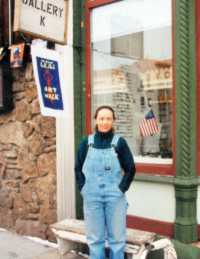Review by Abby Quillen
Mountaineer – April 2002 – Colorado Central Magazine
Betsy Cowles Partridge: Mountaineer
by Janet Robertson
Published in 1998 by the University Press of Colorado.
ISBN 0-8708148-0-x.
IN 1933, AT 31 YEARS OF AGE, Betsy Cowles Partridge climbed her first two fourteeners — Mount Lincoln and Mount Bross near Fairplay. It was a feat for someone who had reportedly never shown the “slightest interest in or aptitude for athletics of any kind.”
But for Partridge, it was just the beginning. She went on to become the twenty-sixth person to climb all of Colorado’s fourteeners, and to climb extensively in Switzerland, the Tetons, and Columbia. And, at 48, she was a member of the Houston Expedition, the group that made the first approach to Mount Everest from the south through eastern Nepal. By the time of her death, Partridge was known as “America’s foremost woman mountaineer.”
Janet Robertson has offered us a chronicle of this early female trailblazer in Betsy Cowles Partridge: Mountaineer.
The book leaves no question that Partridge achieved many things in her life. However, this is not a story about a woman who fought to overcome the status quo. Although a pioneer among women mountain climbers, Partridge was not exactly a Sojourner Truth or Elizabeth Blackwell. She seemed to have little interest in improving women’s lot in life.
Unlike Dorothy Teague Swartz, a younger woman who climbed at the same time, Partridge hardly seemed to notice the injustices toward American female climbers, although they were certainly present. It was not until the 1950s that the American Alpine Club decided that women were competent enough to go on expeditions, and even then only a select few were considered, and they were often expected to cook and darn socks to earn their place on a trip. Nevertheless, despite Partridge’s accomplishments in the climbing world, she was, for the most part, comfortable taking the back seat on expeditions and deferring to men as the experts.
Partridge was also not a woman who had to fight her way to the top socially. She led a privileged life. After attending Vassar College, she married Bob Cowles and moved to Colorado, where she joined the high society of Colorado Springs.
Unlike most of us, Partridge never had to work. And, when she took up climbing, she had all the time and support she needed to travel and hike. Even after her marriage to Bob Cowles soured, he continued to support her and money was never an issue.
Perhaps it is unfair to judge Partridge for her wealth and resources. Janet Robertson thought so. In the prologue, she scoffs at a critic of Partridge’s who focused “on the outward trappings of Betsy’s privileged life rather than the person herself.” But, Betsy Cowles Partridge’s high-society lifestyle can make her a hard woman to identify with.
DESPITE THAT, Partridge is a likable character. By all accounts, she was warm and witty and generous. As her nephew said, “everyone who ever met Betsy fell a little bit in love with her.” Indeed, the places where the book reveals Partridge’s personality are the most compelling parts. Robertson points out that Partridge was a lady of paradox: a tough climber who weathered rugged terrain, who also reveled in her femininity. Partridge insisted on carrying lipstick in her backpack and wearing color-coördinated climbing gear.
But, unfortunately, although Robertson writes in the prologue that the “book is mostly about Betsy and the fascinating paradoxes in her personality,” it’s not. The author spends more time on detailed accounts of Partridge’s expeditions than she does on anything else. Betsy Cowles Partridge was not only a climber, but also a published writer, and Robertson quite liberally quotes from Partridge’s works, which are very detailed accounts about her climbing trips that reveal little about her personality. Robertson includes so many of these accounts — they go on for up to eight pages at a time — that it can make the reader wonder whether it was Partridge or Robertson who wrote more of the book.
However, one thing is sure, Robertson definitely did her research. She not only drew on Partridge’s papers, trip diaries, and published articles, she also interviewed a vast number of Partridge’s friends, family, and fellow climbers. And, if anyone is qualified to write about mountaineering, it is Janet Robertson. She, like Partridge, has climbed all of Colorado’s fourteeners. In 1993, Robertson actually followed Partridge’s historic 1950 trek in eastern Nepal so that she could write knowledgeably about it.
As a recent history student, I found the research that went into the book astounding, and I couldn’t help but marvel at Robertson’s impeccable annotations and index. The writing, too, was technically flawless, although a bit dry as academic works tend to be. Robertson’s bibliography and index alone make this account an excellent research source for history scholars interested in the ins and outs of twentieth century mountaineering.
However, for the general reader interested in the history of Central Colorado, this is probably not the book to choose. Although Betsy Cowles Partridge spent much of her life in Colorado Springs, just two hours away from our part of the state, she could have been in a different country. She obviously climbed extensively around here, but the book mentions little about the people or the places she visited in this part of Colorado. The only mention of Salida is that she went through it on a bike ride once.
And, out of all of Partridge’s very detailed accounts of mountain terrain that Robertson includes in the book, none of them are about Colorado’s mountains. For a book printed by the University Press of Colorado, the book goes into more detail about the history and geography of Nepal than it does about Colorado. And, what Robertson does include about our state, like the parts about high society life in Colorado Springs, often seem just as far away from here as Nepal is.
–Abby Quillen

